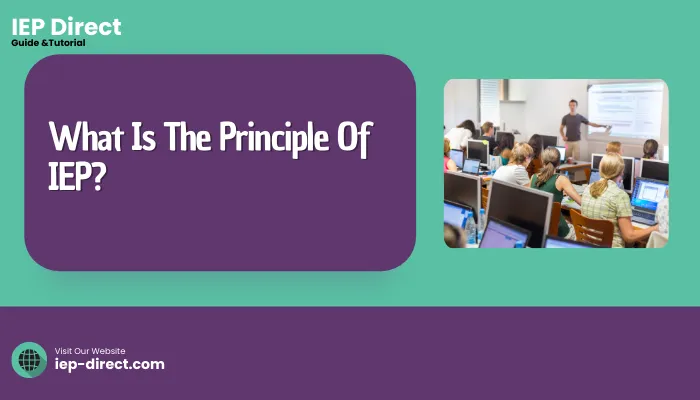One of the fundamental questions asked is what is the principle of IEP Direct? To answer that, components of special education is an Individualized Education Program (IEP), which serves as a custom-designed plan for children with learning disabilities.
This program ensures that every student gets the necessary support and instruction they need to succeed. Let’s talk more about the core principles contained in an IEP.
Let dig more about the principle of IEP.

What Is The Principle Of IEP: Customized Learning
The basis of what is the principle of IEP lies in the personalization principle, meaning no two are alike. Each one is handcrafted to suit the individual needs, strengths, and learning style of a learner, much like tailoring a dress made uniquely for someone. enhancing their academic journey.
Here are some tips to enhancing their academic journey:
- Unique Needs Matter: A disability makes every kid unique from another. Likewise, their abilities and objectives differ significantly.
- Holistic Approach: Looking into all aspects of someone besides just their disability forms part of IDEA.
- Flexibility: The IEP aims at changing along with the child’s condition or capabilities over time.
Therefore, Personalization means fitting education to suit children rather than forcing them to fit into it.
The IDEA Framework
The main part of what is the principle of IEP is federal law secures Free and Appropriate Public Education (FAPE) for disabled learners.
Think of it as the special education constitution; this is why we have IEPs and the reason are below:
- Mandate for IEPs: Schools must develop and implement individualized educational programs according to IDEA that applies only to qualified individuals enrolled in these institutions.
- Eligibility Criteria: To qualify for special education support services, students must fall into certain specified categories of disabilities.
- Procedural Safeguards: These rights guarantee that individuals and their families are protected as they move through the process of IEP development.
Therefore, FAPE exist to support more disabled children.
FAPE Commitment
IDEA is based on Free Appropriate Public Education (FAPE), which means that educational institutions must not charge parents for their children to attend and must be able to customize their education effectively according to the individualized requirements of each child.
This practice illustrates what is the principle of IEP by ensuring education is tailored to meet each student’s unique needs.
- Individualized: All students have unique needs, and therefore, FAPE cannot be a one-size-fits-all policy. There are a lot more advantages behind this concept than drawbacks.
- Meaningful Benefits: This implies that when an IEP is implemented, it ought to yield something beyond progress towards one’s education since quality education also counts in school success.
- Least Restrictive Environment (LRE): As much as possible, IDEA suggests educating children with disabilities alongside those without disabilities.
Therefore, Understanding FAPE and the principle of IEP ensures that education is both individualized and inclusive. This approach promotes meaningful benefits and the least restrictive environment (LRE) for all students.
Empowering Your Child
In addition to setting up schools’ responsibilities under this law, IDEA also includes important rights for students who suffer from disabilities and their parents. These laws ensure that the school system is accountable and that family members’ active participation in the child’s academic matters will enhance their development.
- Parent Involvement: Parents have rights to participate in any decisions pertaining to evaluation, planning, and placement processes involving their children with special needs.
- Access to Information: Parents can review records relating to their kids’ education and join in developing IEPs through scheduled conferences with instructors.
- Dispute Resolution: If parents disagree with the school’s decisions, they have the right to request mediation or due process hearings.
Understanding the legal framework of IEPs is essential for protecting your child’s rights and advocating for their educational needs.
A Team Effort
Creating a successful IEP involves a dedicated team of individuals who bring diverse perspectives and expertise to the table.
- Key Players: Typically, the IEP team includes (when it is appropriate to do so) students, parents, teachers in general education as well as special education, a school administrator, and service providers like speech therapists or occupational therapists.
- Shared Responsibility: Everyone has a role to play in acquiring information about the student, setting goals, and determining what supports best work for them.
- Open Communication: Good communication amongst all involved is vital for an effective IEP development process.
Therefore, team efforts plays an very important role to bring new perspective as it helps IEP to grow.
IEP Meetings
IEP meetings are where the magic happens. These meetings bring together the IEP team to discuss student progress, set goals, and make decisions about services.
- Purposeful Discussions: During these meetings, discussions should be goal-oriented and productive. They must have clear agendas with everyone prepared.
- Collaboration is Key: The most effective IEP meetings are those where people feel heard and validated; collaborative exercises help in finding solutions that work best.
- Parent Involvement: The parent’s input into any discussions about their child is invaluable since they know more than anyone else about their strengths and weaknesses among other things.
Purposeful discussions, teamwork, and active parent involvement characterize effective IEP meetings. These classes prioritize specific topics and appreciate the contributions of every member, which yield customized remedies to individual children’s particular needs.
Regular IEP Reviews
An IEP is not something set in stone; it is a living document. Routine reviews ensure the continued relevance of this document to the changing requirements of students.
- Annual Reviews: At least once per year, an evaluation conference should convene to consider how far the child has advanced and make any necessary changes.
- Progress Monitoring: Periodic checks by teachers and parents should be made to establish whether there has been any growth in the learning of a student that might require more help.
- Flexibility: If a student’s needs change significantly, an IEP can be revised more frequently.
By following these steps and fostering a collaborative environment, schools can create and implement IEPs that truly make a difference in the lives of students with disabilities.
Benefits Of IEP
IEPs are intended to foster an inclusive and effective educational setting for students with disabilities. When properly implemented, they have recorded notable academic improvements as well as general well-being among students.
- Tailored Instruction: Teachers can customize instruction materials or methods based on what best fits the individual learner’s style of learning or pace.
- Access to Curriculum: When provided with necessary supports, handicapped individuals manage to participate fully in regular classroom activities and access the general education curriculum.
- Skill Development: An IEP concentrates on developing skills that are essential for independent living, like making choices, solving problems, and socializing.
- Increased Confidence: The success realized in classrooms leads to increased confidence levels among learners, which ultimately means greater self-esteem.
Individual Support
One of the biggest strengths of an IEP is its provision for personalized aid. They offer all the specific assistance a disabled child requires for better performance.
- Specialized Services: Sometimes, IEPs encompass such services as speech therapy or counseling alongside occupational therapy provided as related services addressing specific needs.
- Accommodations: These could be slight adaptations to either learning procedures or environments, which would tremendously boost how successful pupils can be.
- Assistive Technology: Assistive technology software or equipment may be part of an IEP to assist students in accessing information and completing tasks.
- Progress Monitoring: Continuous assessments keep a record of how far a student has come and ensure that the IEP is serving them appropriately.
By giving personal assistance and creating an individualized learning experience, IEPs help people with disabilities achieve their highest potential.
Conclusion
We have covered everthing about what is the principle of IEP. In short Individualized Education Program (IEP) is a powerful tool that can transform the educational experience for students with disabilities. Knowledge of the basic concepts of the IEP will allow us to understand its impact on our citizens’ lives.
Recap:
- Personalization: Each plan is tailored according to each child’s unique requirements, thus ensuring personalized learning.
- Legal Framework: IEPs are grounded in the Individuals with Disabilities Education Act (IDEA), which guarantees school-based services for children with disabilities within a Least Restrictive Environment (LRE).
- Collaboration: An effective team effort from parents, teachers, and other specialists is necessary to develop and put into practice IEPs.
- Benefits: Enhancing the educational experience, individualizing support, and better outcomes for disabled learners characterize IEPs.
IEP is more than just a piece of paper, it signifies dedication towards enabling students with different needs to succeed. Together, we can create inclusive classrooms where every child can flourish.
